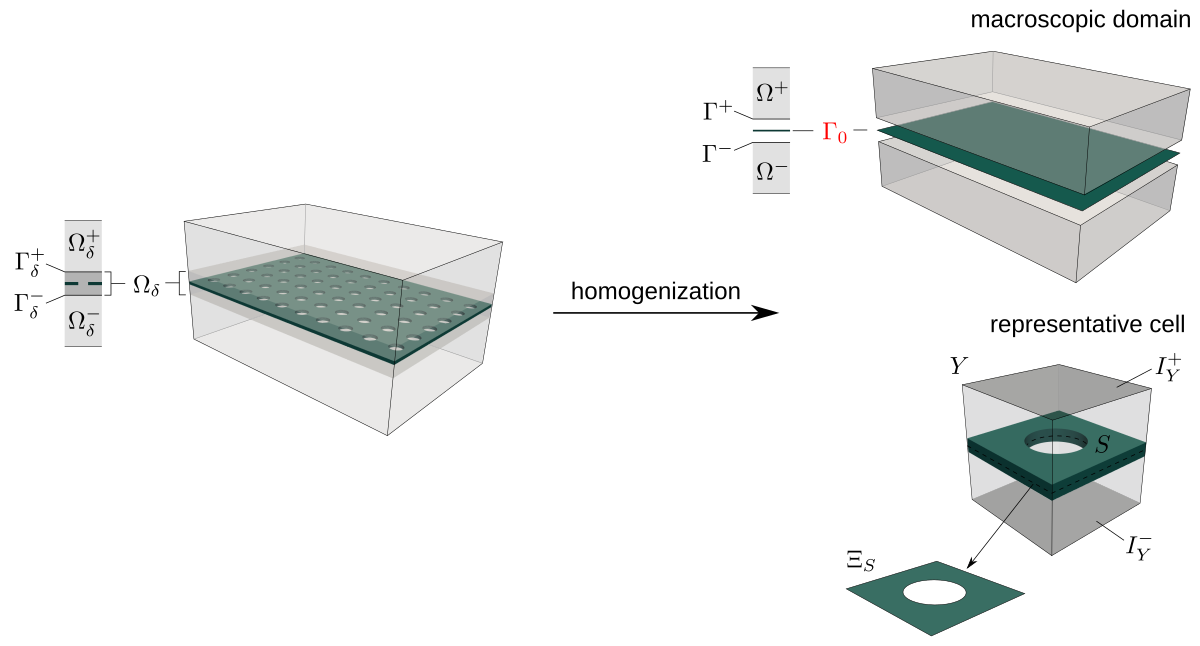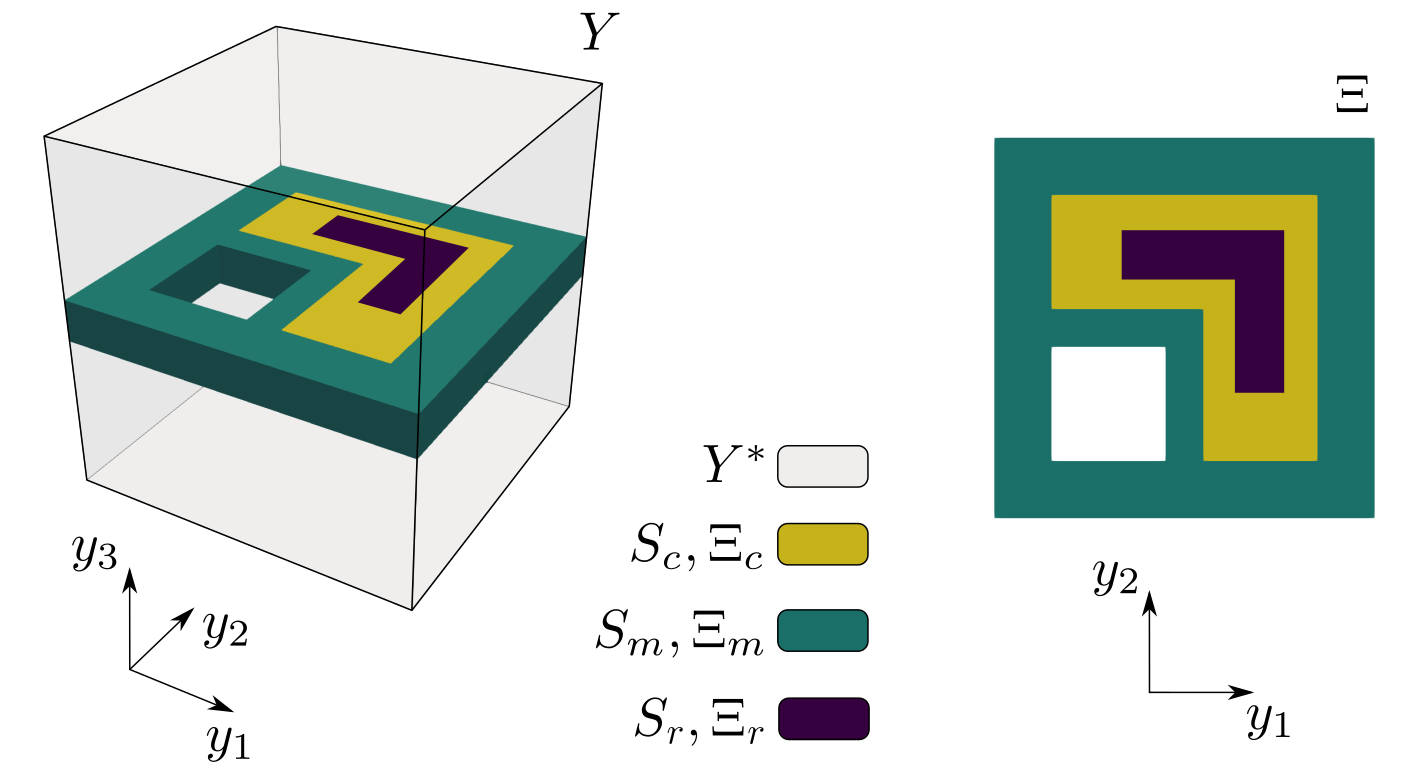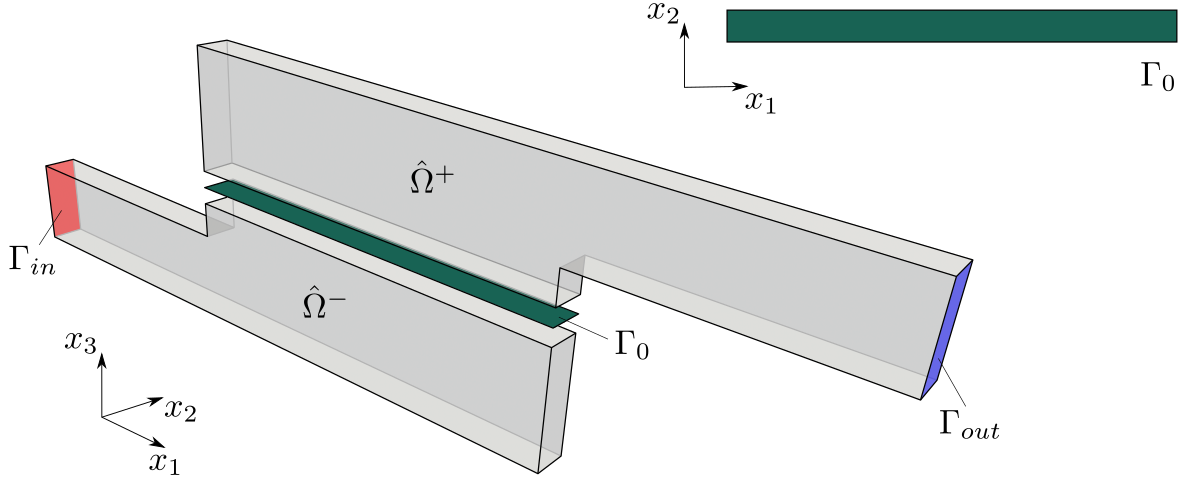Homogenization of the vibro-acoustic transmission on perforated plates with embedded resonators¶
Mathematical model¶
This example presents the implementation of the homogenized model of the acoustic transmission on perforated plates described in [RohanLukes2021]. The elastic plate interacting with an inviscid fluid is replaced by an interface on which the homogenized transmission conditions are applied, see Fig. 1.

Fig. 1 Transmission layer  of thickness
of thickness  embedded in
the global domain
embedded in
the global domain  is replaced by the homogenized interface
is replaced by the homogenized interface  . The solid
part
. The solid
part  of the representative cell
of the representative cell  corresponds to the perforated plate.
corresponds to the perforated plate.
The frequency dependent homogenized coefficients are computed using
characteristic responses of the representative cell which consists of the fluid
part  and the solid plate
and the solid plate  embedding the
elastic inclusion
embedding the
elastic inclusion  and the resonator
and the resonator  as
illustrated in Fig. 2.
as
illustrated in Fig. 2.

Fig. 2 The computational domains  and
and  involved in the calculations
of the characteristic responses and the homogenized coefficients.
involved in the calculations
of the characteristic responses and the homogenized coefficients.
Equations describing the homogenized transmission layer involve the homogenized
coefficients and are solved in the macroscopic domain  and are
coupled with the global acoustic field defined in
and are
coupled with the global acoustic field defined in  .
.
Numerical implementation¶
The problem of homogenized coefficients and the global macroscopic equations
are discretized and solved by means of the finite element method. The frequency
dependent coefficients are defined in acoustics_micro.py and the
frequency independent coefficients calculated within the 2D plate
representation  are specified in
are specified in acoustics_micro_plate.py.
The homogenization engine of SfePy, see [CimrmanLukesRohan2019], is employed
for their effective calculation.
At the macroscopic level, we consider the waveguide which domain is divided by
the perforated plate into two parts of the same shape and size, see
Fig. 3. The waveguide input is labelled by  and the
incident wave is imposed on this boundary. The anechoic boundary condition is
considered at the waveguide output which is labelled by
and the
incident wave is imposed on this boundary. The anechoic boundary condition is
considered at the waveguide output which is labelled by  .
The definition of the macroscopic problem is in files
.
The definition of the macroscopic problem is in files
acoustics_macro.py and acoustics_macro_plate.py. The first file
specifies the equations and variables related to  ,
,
 while the second one defines the equations associated with the
homogenized interface
while the second one defines the equations associated with the
homogenized interface  .
.

Fig. 3 The computational domains  ,
,  ,
,
 employed in the numerical simulations of the acoustic
transmission at the global (macroscopic) level.
employed in the numerical simulations of the acoustic
transmission at the global (macroscopic) level.
The whole two-scale analysis is govern by the acoustics.py script which
invokes the homogenization procedures and runs the simulation at the
macroscopic level.
Running simulation¶
To run the numerical simulation, download the archive, unpack it in the main SfePy directory and type:
python example_vibroacoustics-2/acoustics.py
By running the resview.py script, you can visualize the distribution of
the global pressure field calculated for frequency  Hz:
Hz:
./resview.py example_vibroacoustics-2/results/waveguide_mesh_w33000_p.vtk -v "270,90"
and e.g. the deflection field calculated at the interface  :
:
./resview.py example_vibroacoustics-2/results/waveguide_mesh_w33000_dp0.vtk -v "0,0" --position-vector "0,2,0" -f real.w:p0 imag.w:p1
References¶
| [RohanLukes2021] | Rohan E., Lukeš V. Homogenization of the vibro-acoustic transmission on periodically perforated elastic plates with arrays of resonators. Applied Mathematical Modelling, 2022, DOI:10.1016/j.apm.2022.05.040 |
| [CimrmanLukesRohan2019] | Cimrman R., Lukeš V., Rohan E. Multiscale finite element calculations in Python using SfePy. Advances in Computational Mathematics, 45(4):1897-1921, 2019, DOI:10.1007/s10444-019-09666-0 |

 .
.